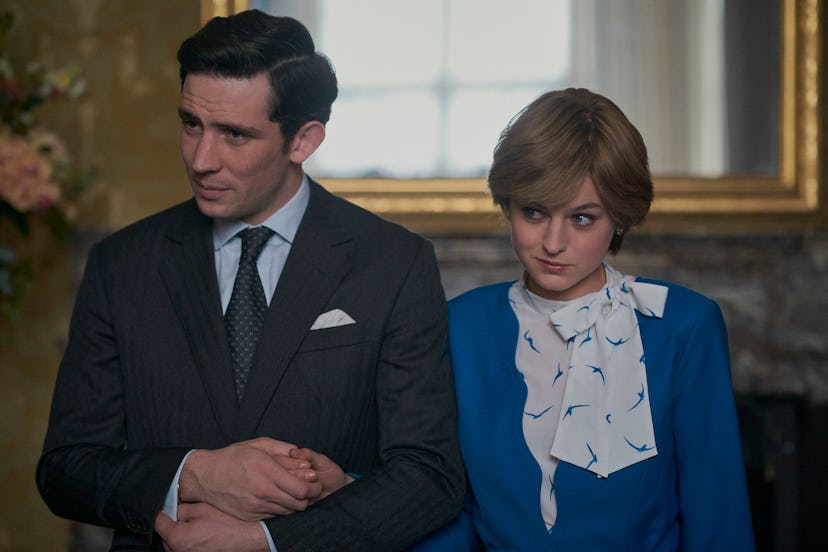Finding Romance in the Sadness of The Crown Season Four
This newest season of the Netflix hit is devoid of affection and love—but somehow, the show retains a sense of dazzling romance.

This past summer, fans of The Crown were inundated with rave reviews, cinematic stills, and hype for its latest go-round, season four—and I’m here to give you some more. The new season is not only visually compelling, but the story tugs at heartstrings in a new way, with the introduction of Lady Diana Spencer, her life unfolding within the Royal Family’s powerful grasp.
The Netflix series originally aired in 2016, taking viewers through the Royal Family’s influence on not just the world, but within its own family’s relationships and dynamics. In season four, the incredible Olivia Colman plays the Queen, circa the 1980s. Even those not familiar with British politics can be engrossed in the subplots, which include Margaret Thatcher’s rise as the UK’s first female Prime Minister and the story of Michael Fagan breaking into the Queen’s bedroom.
Of course, everyone’s eyes were peeled this season for the narrative involving Diana, played by Emma Corrin, and Prince Charles, played by Josh O’Connor. Corrin embodies Diana so accurately, it’s almost eerie. The way she holds herself, speaks, and her mannerisms are so well-studied—as all the characters are in The Crown. Diana’s sensitivity and ability to relate to the public rendered her beloved, and this season does such a beautiful job of showing how affectionate she was—especially with the public, and her two boys, William and Harry. Celebrations in her name were incessant, and through the episodes, the viewer sees the contrast of the praise from the public and the loneliness Diana faced day-to-day.
Diana’s relationship with Charles and her spiraling health culminate in a mood that’s quite simple to describe: it’s dark. Very dark.
Their marriage was never set out for success, as Charles’s love for Camilla Parker Bowles outweighed his interest in Diana. The various attempts to reconcile Diana and Charles’s love always seemed to fail, leaving them both angry. You can’t help but feel for them both. Charles wasn’t able to be with the woman he loved, as politics required him to stay married to Diana. There’s a compelling scene where Charles desperately asks the Queen for permission to divorce Diana, and the Queen’s response to his request is nothing but indifferent.
Diana suffered in a totally different way. Her youth gave her hope in a marriage that was hopeless. She believed in their relationship for a while, then realized she would never be accepted by the family into which she married. Diana was also notorious for her eating disorder. The loneliness manifested itself physically, as Diana developed bulimia, widening the chasm between her and Charles. The realness in which the disorder is portrayed is chilling, so much so that it might be triggering for some. Dark, quiet, echoey frames take you fully into Diana’s sadness, and the dismissal of it by everyone around her makes you ache for her.
There is a very obvious lack of romance in Diana and Charles’s relationship, and the isolation and mental health issues that Diana faced are anything but romanticized. However, I still feel the entire series has a sort of romantic quality. Maybe it’s me, being an American and looking at the Royal family as Americans do—with an obsessive quality. After all, their lives feel untouchable and The Crown provides an inside glimpse. Or maybe it’s the quality of the show, the precision in which everything is done—the accuracy of the characters’s mannerisms, the time that was very obviously spent learning another person’s behaviors. And of course, the sets and cinematography are astounding. The show is slow, and melodic—and although the story can be gritty at times, especially when it comes to the Royal Family’s many flaws, its thoughtfulness and attention to detail still draws me in, four seasons later.
Related: The Crown Fact Check: Were the Queen’s Cousins Hidden in an Asylum?